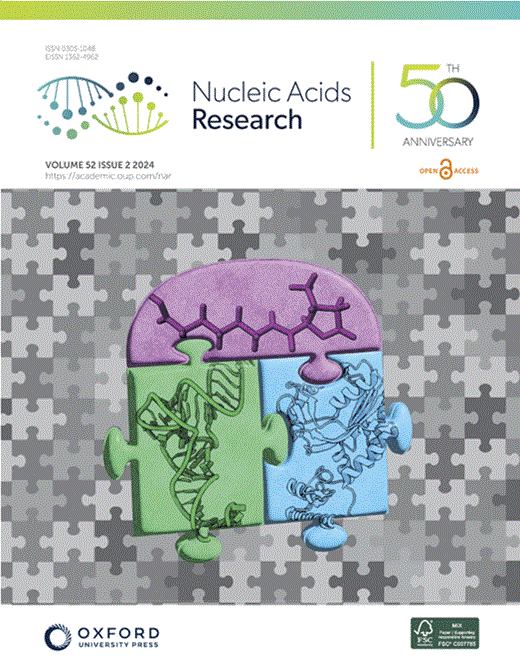Catalytic-state structure of Candidatus Hydrogenedentes Cas12b revealed by cryo-EM studies.
IF 16.6
2区 生物学
Q1 BIOCHEMISTRY & MOLECULAR BIOLOGY
引用次数: 0
Abstract
The CRISPR-Cas (clustered regularly interspaced short palindromic repeats and CRISPR-associated protein) systems are adaptive immune mechanisms that play critical roles in defending archaea and bacteria against invading entities. These systems can be divided into two classes, with class 2 comprising three types (II, V, and VI). Because of their ability to cleave double-stranded DNA, many class 2 CRISPR-Cas proteins have been harnessed as genome editing tools. Unlike the well-studied type II Cas9 proteins, the structural studies of the type V-B Cas12b proteins are limited, hindering their engineering and broader application. Here, we report four complex structures of ChCas12b, which reveal many unique structural features. The folding of the single guide RNA (sgRNA) of ChCas12b is distinct from that of AacCas12b and BthCas12b. Notably, many of these unique features are involved in ChCas12b-sgRNA interaction, suggesting that they are co-evolved. While ChCas12b shares a conserved two-cation-assisted catalytic mechanism with its homologs, it recognizes a longer guide:target heteroduplex, potentially offering higher fidelity in DNA editing. Altogether, our studies suggested that Cas12b family proteins exhibit significant diversity in their folding, sgRNA and target DNA binding. In the future, it is worth characterizing more representative proteins to identify CRISPR-Cas proteins with higher gene editing ability and fidelity.cro - em研究Candidatus hydrogenentes Cas12b的催化态结构。
CRISPR-Cas(聚集规律间隔的短回文重复序列和crispr相关蛋白)系统是适应性免疫机制,在保护古菌和细菌免受入侵实体的侵害中发挥关键作用。这些系统可分为两类,第二类包括三种类型(II、V和VI)。由于它们具有切割双链DNA的能力,许多2类CRISPR-Cas蛋白已被用作基因组编辑工具。与已被充分研究的II型Cas9蛋白不同,V-B型Cas12b蛋白的结构研究是有限的,这阻碍了它们的工程和更广泛的应用。在这里,我们报道了ChCas12b的四个复杂结构,揭示了许多独特的结构特征。ChCas12b的单导RNA (sgRNA)折叠方式不同于AacCas12b和BthCas12b。值得注意的是,许多这些独特的特征都与ChCas12b-sgRNA相互作用有关,这表明它们是共同进化的。虽然ChCas12b与其同源物共享保守的双阳离子辅助催化机制,但它识别更长的向导:靶异双工,可能在DNA编辑中提供更高的保真度。总之,我们的研究表明,Cas12b家族蛋白在折叠、sgRNA和靶DNA结合方面表现出显著的多样性。未来值得对更具代表性的蛋白进行表征,以鉴定出具有更高基因编辑能力和保真度的CRISPR-Cas蛋白。
本文章由计算机程序翻译,如有差异,请以英文原文为准。
求助全文
约1分钟内获得全文
求助全文
来源期刊

Nucleic Acids Research
生物-生化与分子生物学
CiteScore
27.10
自引率
4.70%
发文量
1057
审稿时长
2 months
期刊介绍:
Nucleic Acids Research (NAR) is a scientific journal that publishes research on various aspects of nucleic acids and proteins involved in nucleic acid metabolism and interactions. It covers areas such as chemistry and synthetic biology, computational biology, gene regulation, chromatin and epigenetics, genome integrity, repair and replication, genomics, molecular biology, nucleic acid enzymes, RNA, and structural biology. The journal also includes a Survey and Summary section for brief reviews. Additionally, each year, the first issue is dedicated to biological databases, and an issue in July focuses on web-based software resources for the biological community. Nucleic Acids Research is indexed by several services including Abstracts on Hygiene and Communicable Diseases, Animal Breeding Abstracts, Agricultural Engineering Abstracts, Agbiotech News and Information, BIOSIS Previews, CAB Abstracts, and EMBASE.
 求助内容:
求助内容: 应助结果提醒方式:
应助结果提醒方式:


